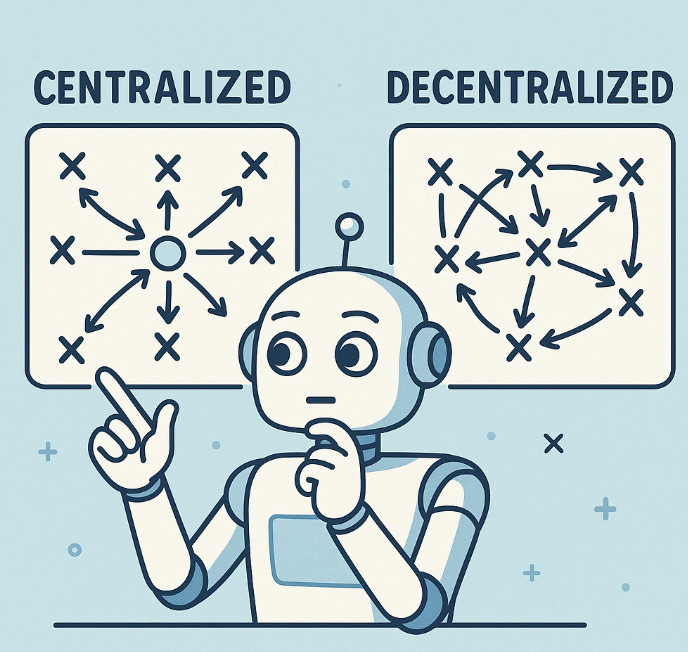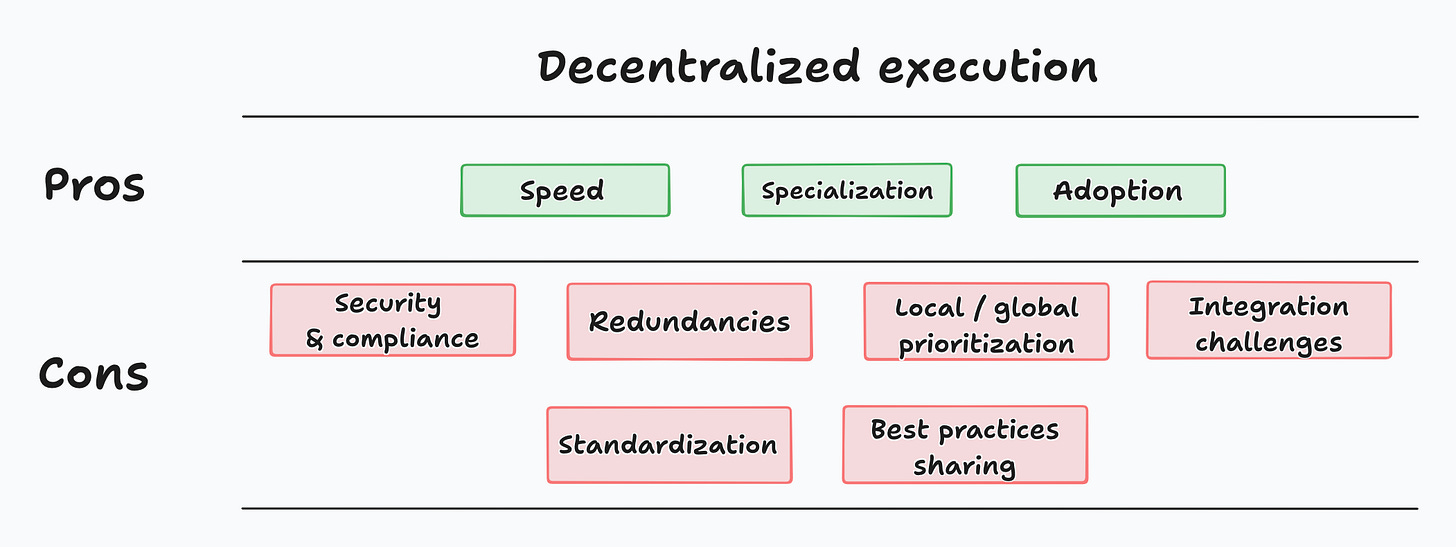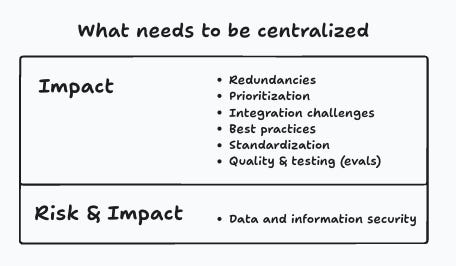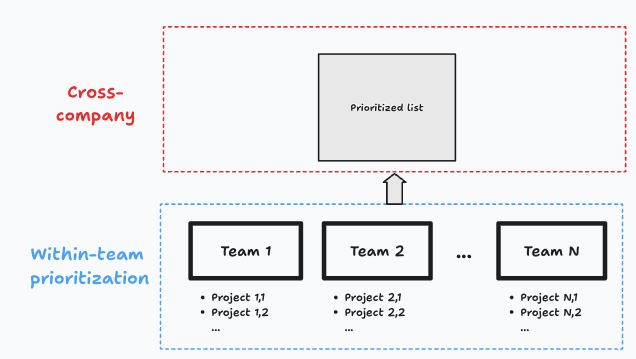TL;DR
A successful adoption needs to be realistic, managed, and measurable.
Decentralized execution means trusting the teams to own the tools and transform how they operate.
A centralized vision ensures coordination, cooperation and risk management.
Small companies may prefer centralized execution and vision. A Center of Excellence might work well for them.
A fully decentralized prioritization strategy may lead to suboptimal outcomes.
A messy adoption strategy is problematic, but it may be better than an over-strategized one.
In a previous post I talked about having a centralized vision and a decentralized execution when implementing your GenAI adoption strategy. I realize that this might sound like corporate speak, so in this post I want to clarify what this means in practice, and discuss some of the underlying logic behind it.
Defining success
In the past, I’ve found it most fruitful to start with a clear definition of success, and then reverse engineer an org structure that supports it.
Success for GenAI adoption
A company will have a successful adoption of GenAI if it creates impact that is:
Measurable: GenAI has been embedded into the operating process and has measurable impact.
Realistic: impact is measured relative to what is possible given current constraints.
Managed: potential risks are calculated, mitigated and managed
Measurability is critical if we want to ensure that impact is real. I’ve seen companies where everyone says they’re doing GenAI, but there’s no real impact. It also imposes a metrics discipline that many companies lack. Also, if you can measure impact, you can align adoption to milestones (and performance reviews) if required.
One risk of over-strategizing is setting up unrealistic expectations about what can be done. Realism implies that impact is measured relative to the right baseline, and respects technological, technical and organizational, and even sector-specific constraints. It will also minimize organizational frustration.
A successful adoption needs to be realistic, managed, and measurable.
Finally, success requires taking into account the risks, and should be very transparent about the trade-offs between short- and longer-term success. GenAI — being general, probabilistic and “black-boxy” — creates a new set of challenges for organizations that must be recognized from the outset.1
Decentralized execution
Decentralized execution means giving full ownership to individual teams to develop and deploy their own GenAI solutions, as opposed to waiting for a central team to either approve, or assign a budget or resources.
The case for this pattern is usually made on the grounds of speed and domain expertise, but I’ll also add adoption. Who better than the team who owns a process to build a solution? It can also be prioritized to meet a plan that is consistent with the team’s capabilities and other priorities. Finally, playing an active role in the end-to-end planning and execution helps ensure adoption of the solution.
Decentralized execution means trusting the teams to own the tools and transform how they operate.
Centralized vision
Achieving speed through specialization and ensuring adoption are critical to create measurable impact, but are by no means sufficient. At the limit, one can think of having full decentralization where each developer or AI engineer decides what to do and how to do it. As any team leader can attest, there are many reasons for this to be problematic, and naturally the same rationale applies also at the company level.
A centralized vision (and control) might be required for risk management purposes, as is the case with information security and compliance. The definition of “acceptable risks” is naturally born at the company level, and includes compliance and strategic considerations that ought to be enforced widely.
But a central vision is also necessary to ensure maximum impact. Key considerations are avoiding redundancies (e.g. “teams A and B are working on the same project”), global vs. local prioritization (what matters at the team level may have a relatively low impact at the company level), GenAI infrastructure compatibility and integration challenges (e.g. APIs from team A are not usable by other teams because they decided to use different standards and technologies), information acquisition and sharing best practices, and finally, having a robust evaluation framework.
A centralized vision ensures coordination, cooperation and risk management.
What about centralized execution? Scale and maturity matters
Decentralized execution works well in companies that are mature enough and have large enough decentralized teams or squats. So what happens with everyone else?Small enough companies may find a centralized operation optimal, effectively trading off specialization with prioritization. A similar rationale applies for companies that are barely starting their machine learning or GenAI journeys.
Centers of Excellence (CoE) are a typical example of a centralized vision and (quasi) decentralized execution. I’m using the “quasi” qualifier because they aren’t really decentralized in the way I’ve described before: they operate as a team of experts that are temporarily embedded in teams.
The short-term character of their involvement makes them less specialized than a fully embedded team, but there are many examples where GenAI does not require substantial domain knowledge.
CoEs are a good alternative for small companies or those just starting their GenAI journey, as the provide a good compromise between specialization and prioritization.
Local vs. global prioritization
Team-level prioritization may not lead to optimal aggregate outcomes since projects of relatively low value at the company level may end up being deployed by individual teams. A possible solution is to have a hybrid centralized/decentralized prioritization scheme, where a bottom-up process of within-team prioritization is followed by a top-down decision-making process.
The actual top-level decision-making process will vary from company to company. Mature-enough companies may delegate this on a C-suite role (say, the Chief AI Officer), but other companies may wish to do this by way of a committee. At the beginning you may also wish to start with “quick wins” (even if of relatively low-value) since this may speed adoption and buy-in.
A fully decentralized prioritization strategy may lead to suboptimal outcomes.
What’s next
As I mentioned before, it’s important to avoid over-strategizing. For instance, some companies have chosen to start with a messy adoption strategy, and this may result in better outcomes than formalizing everything on paper with little to no execution.
A messy adoption strategy is not optimal, but it may still be superior to over-strategizing.
In the following posts I’ll cover some other important considerations like democratizing access and deployment and the crucial difference between probabilistic and deterministic systems.
To be fair, the probabilistic nature and lack of interpretability of GenAI is also present in any machine learning (ML) production pipeline. As such, organizations that have already achieved some level of maturity with ML operations have an important advantage.








